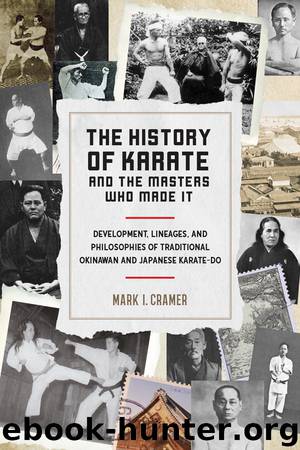The History of Karate and the Masters Who Made It by Mark I. Cramer

Author:Mark I. Cramer
Language: eng
Format: epub
ISBN: 9781623172404
Publisher: North Atlantic Books
Published: 2018-06-05T16:00:00+00:00
Wu Xiangui and Goju Ryu
Wu Xiangui helped to shape the development of Goju Ryu. He was instrumental in Miyagi’s second trip to China in 1936. He accompanied Miyagi and acted as his interpreter. For ten days, the two men stayed as guests at the home of one of Wu’s White Crane Boxing students and tea trading partners. While in China, Miyagi demonstrated karate-do and was also introduced by Wu Xiangui to Miao Xing, a Monk Fist Boxing expert. There are some researchers who assert that it was through his exchange of ideas with Miao Xing that Miyagi was inspired to develop the Geki Sai kata.5
However, it must be noted that this assertion about the development of the Geki Sai kata is not without dispute. Whereas no one disputes that the development the Geki Sai kata occurred after Chojun Miyagi returned from his second trip to China, not all researchers agree that his experiences on this trip inspired the development of these kata. Morio Higaonna tells us that there was no connection between Miyagi’s trip to China and the development of the Geki Sai katas: “Miyagi however, was unable to conduct any meaningful research on this trip.”6 Furthermore, Morio Higaonna tells us that Miyagi’s inspiration for developing these kata was quite different: “He had two purposes in mind: the physical and spiritual development of the individual practitioner and increasing the popularity of karate.”7
Morio Higaonna does agree that Miyagi and Wu Xaingui were very close friends. They were frequently in each other’s company and would often engage in recreational activities into the early hours of the morning: “When Miyagi and Go Ken Ki [Wu Xiangui] played chuji (the game of go), as they did frequently, Kina [a student of Miyagi] stayed up all night serving tea and attending to their needs.”8 Their friendship also involved their mutual love of the martial arts, and Miyagi often invited Wu Xiangui to his dojo “to come and demonstrate his art of white crane.”9
Since Miyagi and Wu Xiangui were close friends, were members of the same karate study group, and often trained together in the martial arts, it is safe for one to infer that each of these men influenced the martial arts of the other. The depth and breadth of that influence will often be the subject of debate.
Download
This site does not store any files on its server. We only index and link to content provided by other sites. Please contact the content providers to delete copyright contents if any and email us, we'll remove relevant links or contents immediately.
| Africa | Americas |
| Arctic & Antarctica | Asia |
| Australia & Oceania | Europe |
| Middle East | Russia |
| United States | World |
| Ancient Civilizations | Military |
| Historical Study & Educational Resources |
The Sympathizer by Viet Thanh Nguyen(4098)
The Rape of Nanking by Iris Chang(4025)
World without end by Ken Follett(3347)
Ants Among Elephants by Sujatha Gidla(3282)
Blood and Sand by Alex Von Tunzelmann(3061)
Japanese Design by Patricia J. Graham(3006)
City of Djinns: a year in Delhi by William Dalrymple(2438)
Foreign Devils on the Silk Road: The Search for the Lost Treasures of Central Asia by Peter Hopkirk(2389)
Inglorious Empire by Shashi Tharoor(2349)
The Queen of Nothing by Holly Black(2326)
India's Ancient Past by R.S. Sharma(2306)
In Order to Live: A North Korean Girl's Journey to Freedom by Yeonmi Park(2305)
Tokyo by Rob Goss(2295)
India's biggest cover-up by Dhar Anuj(2251)
Tokyo Geek's Guide: Manga, Anime, Gaming, Cosplay, Toys, Idols & More - The Ultimate Guide to Japan's Otaku Culture by Simone Gianni(2244)
The Great Game: On Secret Service in High Asia by Peter Hopkirk(2231)
Goodbye Madame Butterfly(2163)
Batik by Rudolf Smend(2010)
Living Silence in Burma by Christina Fink(1988)
